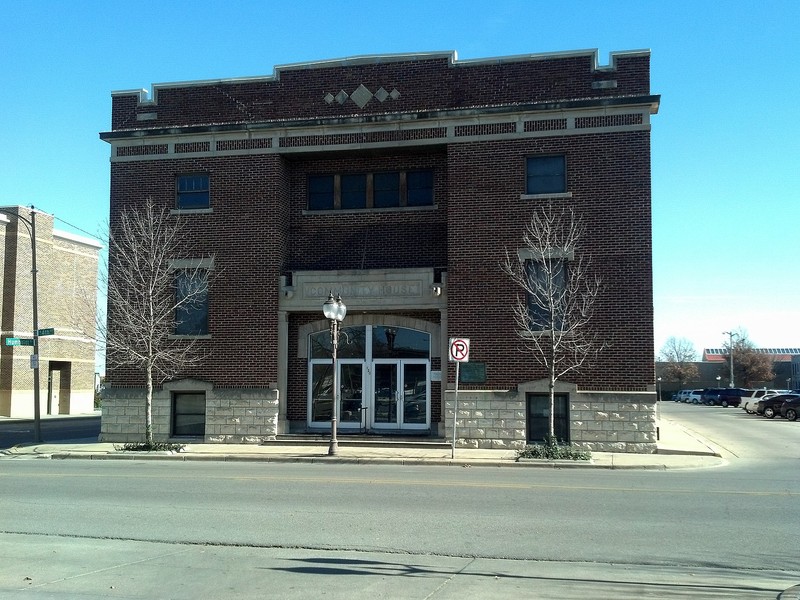Community House
Introduction
Text-to-speech Audio
Images
Community House

Backstory and Context
Text-to-speech Audio
Built in 1917, the Community House in Manhattan, Kansas, played an integral role in Manhattan's association with U.S. military events during the twentieth century (especially World War I) and the community involvement through which it inspired. Purported to be the country's first permanent community building, the Community House's success inspired the Federal Government to encourage other cities to construct similar buildings. After World War II, the building largely served as a community and recreation center until 2019. A multimillion-dollar renovation project led to its conversion into a modern office and loft space, but the developers maintained its historic look.
The Genesis of the Community House
The Rotarians of Kansas, Missouri, and Oklahoma, along with the City of Manhattan, collaborated on building the Community Center. Although most buildings in Manhattan built in the late nineteenth and early twentieth century consisted of limestone (a stone native to Kansas), the Community House is primarily brick. Although it opened in 1918, near the end of World War I, the collaborators had intended to create a place suitable for soldiers to sleep and be entertained, as well as keep their minds off the war.
General Leonard Wood attended the grand opening in 1918. Wood, an acclaimed military officer, fought in the 1st Volunteer Cavalry (the Rough Riders) and, as a colonel, led it in its Cuban operations, including at San Juan Hill. He also served as governor of the Moro Province in the Philippines from 1903 to 1906 (and governor-general of the Philippines from 1921-1927), as a special ambassador to Argentina, and as the U.S. Army Chief of Staff. Additionally, he trained the 10th Division at Camp Funston during World War I. Wood also tried his hand at politics when he ran unsuccessfully for the Republican nomination for president in 1920.
From World War I through World War II
During the First World War, the War Camp Community Service managed the Community House. Numerous soldiers trained at nearby Camp Funston and Fort Riley during World War I. The Community House provided the soldiers with cots for sleeping, offered them stationary for writing family and friends, provided magazines and a billiards room, and hosted events such as concerts and dances. For those already shipped overseas, the Community House functioned as a place where family members could go and receive information about their whereabouts. During the interwar period of the 1920s and 1930s, the City of Manhattan managed the Community House, which functioned dually as an American Legion post and the Manhattan Chamber of Commerce headquarters. After the bombing of Pearl Harbor, the Federal Government bought the Community House and used it to host USO and community events.
The success of the Community House inspired the Federal government to budget more than $4 million for the construction of more community centers in cities throughout the U.S.
Post WWII
Despite the continued U.S. military involvement in overseas conflicts such as Korea and Vietnam, the Community House transitioned into a community and recreation center in the years after World War II. As well, some city employees maintained offices on the building's first floor. In recent years, it has been the home to the Manhattan Parks and Recreation Dept. and known as the Douglass Recreation Center. Until 2019, the building lived up to its Community House name, having served the Manhattan community for more than a century.
2019 -
A real estate developer purchased the historic building in 2019 and headed a project to refurbish and renew the building, turning it into a space suitable for modern office suites, a reception and conference area, a few one-bedroom lofts, and space available for community meetings and receptions. Although the building underwent significant renovations, the developers maintained its historic appearance.
Sources
Doering, Greg. "Local Developers See Bright Future for the Community House." mhk Business News. December 18, 2019. https://mhk.business/local-developers-see-bright-future-for-the-community-house/.
Garcia, Rafael. "For $1, city wants to sell Community House to developer for new offices, lofts.." The Mercury (Manhattan, KS) June 19, 2019. https://themercury.com/news/for-1-city-wants-to-sell-community-house-to-developer-for-new-offices-lofts/article_f2fed64e-27aa-56ff-97a6-7e2dd8daffac.html.
"Major General Leonard Wood." The Army Historical Foundation. armyhistory.org. Accessed May 13, 2021. https://armyhistory.org/major-general-leonard-wood/
Tangeman, Leslie M. "Nomination Form: Community House." National Register of Historic Places. nps.gov. 2006. https://npgallery.nps.gov/GetAsset/6b510377-1b3a-4ee6-8f7a-dbbed82136e1.
By spacini - Own workThis photo was uploaded with Wiki Loves Monuments mobile 1.2.5 (Android)., CC BY-SA 3.0, https://commons.wikimedia.org/w/index.php?curid=22531967
